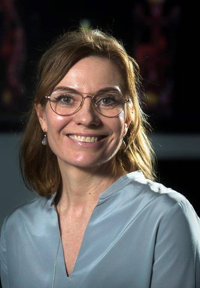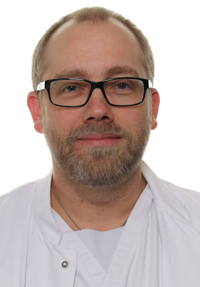Nuclear Medicine
The Department of Nuclear Medicine is an interdisciplinary clinical department without beds. The department receives children and adults, both in-patients as well as outpatients.

Malene Grubbe Hildebrandt
Head of Research
Nuclear Medicine
+45 30 17 18 88 Malene.Grubbe.Hildebrandt@rsyd.dk


The Department of Nuclear Medicine is an interdisciplinary clinical department without beds. The department receives children and adults, both in-patients as well as outpatients. The department comprises three units: Clinical Physiology, Nuclear Medicine, and the PET and Cyclotron Unit, and it primarily serves within four main areas: routine examinations and therapy, education, research & development.
Activities include functional tests and molecular imaging of most tissues and organs as part of diagnosis, choice and control of treatment, and prognosis assessment in a variety of diseases. Moreover, the department is responsible for radioiodine treatment of non-toxic and toxic goiter, thyroid cancers, and radioisotope therapy of some forms of malignant lymphoma. The department receives patients from hospitals and general practitioners on the island of Funen and surrounding minor islands, as well as in the Region of Southern Denmark (1.2 million inhabitants).
The staff comprises approximately 85 employees including physicians, laboratory technicians, physicists, radiochemists, technicians, medical secretaries, one engineer, one biostatistician, one nurse and one service assistant. Besides Abass Alavi, Professor of Radiology, MD, PhD (Hon), DSc (Hon), Department of Radiology, Division of Nuclear Medicine, Hospital of the University of Pennsylvania, is informally affiliated as a scientific consultant and Professor Habib Zaidi, Geneva University Hospital, Switzerland.
The department carries out ultrasound examinations, lung-function tests, and measurement of distal systolic pressure and is equipped with 5 gamma cameras, 3 SPECT/CT scanners, and 4 PET/CT scanners as well as its own cyclotron and radiochemical laboratories for routine production and development of a variety of PET tracers. In addition, the department has developed its own web-based database system, primarily for clinical multicenter studies.
The department is located in the basement of Building 1 (entrance 46) with three entrances: 1 - Nuclear Medicine, 2 - Physiology and 3 PET and Cyclotron Unit.
Being a clinically interdisciplinary department serving almost all medical specialties and all departments at Odense University Hospital research is conducted within topics. For practical purposes the department distinguishes between six clinically-oriented and one translational main area, each covering multiple research fields:
I. Atheromatosis
- Molecular cardiovascular calcification
- Ischemic heart disease
- Heart failure
- Arterial hypertension and cardiovascular disease
- Renal regional blood flow
- Cardiovascular disease in diabetes
- Cardiovascular disease in rheumatoid disease
II. Inflammatory and infectious diseases
- Venous thromboembolic disease
- Systemic inflammation in psoriasis vulgaris
- Pediatric and adult Inflammatory Bowel Disease (IBD)
- COPD and lung inflammation/cor pulmonale
- Diabetic Foot
- Painful joint prosthesis
- Arthritis (cartilage, bone, synovia)
- Infection in immunocompromised patients (HIV, TB, other)
- Fever of unknown origin
- Inflammation in cancer
III. Musculoskeletal system
- Assessment of lumbar fusion
- Hyperalgesia in spinal operated patients
- The inflammatory component in low back pain
- Sodium fluoride PET/CT for assessment of bone mineralization
- Cervico-thoracic angina pectoris
IV. Neurological diseases
- PET in gliomas
- Regional and global cerebral metabolism
- Inflammatory and degenerative disease
- Acute cerebral ischemia
- Neuromyelitis optica
V. Cancer, comprising diagnosis/staging, response evaluation, multiple time point imaging, tumour heterogeneity, standardization of quantification, enzyme activity, targeted diagnostic imaging, etc. in the following types:
- Brain
- Head-and
- Breast
- Lung
- Upper gastrointestin
- Colo-rectal
- Prostate
- Bladder
- Renal
- Ovarian
- Malignant Melanoma
- Malignant Lymphoma
- Multiple Myeloma
VI. Targeted radioisotope therapy
- Neuroendocrine tumours
- Glioblastomas
- Breast, lung, prostate, kidney cancer
VII. Translational
- Radiochemistry: new tracers, microdosing, new platforms
- Small animal PET/CT/SPECT imaging
- Peptides, aptamers, nanoparticles as carriers for imaging and therapeutic isotopes